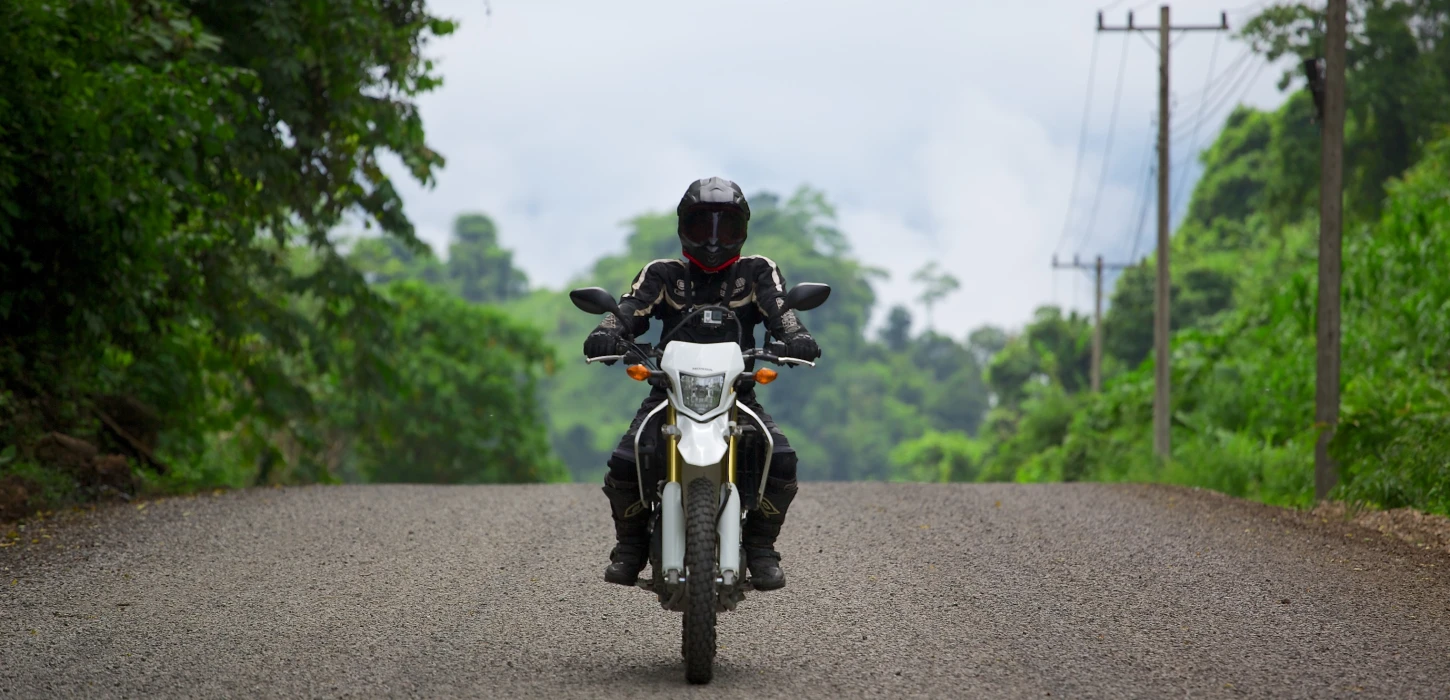Laos is a beautiful country, full of mountainous roads and breathtaking views. Travelling by motorbike is one of the best ways to see this incredible country. There is nothing like the feeling of freedom that comes from riding a bike along mountain roads, stopping whenever you want to take in the views or explore small villages.
But motorbikes also present their own difficulties and unique dangers. To make sure that you get the best out of your motorbike experience in Laos we’ve spoken with the experts to give you the best tips for enjoying your rides safely.
Gear
If you’re going to be riding bikes, your going to want to be protected. The bare minimum is a helmet and gloves. A wide range of motorbike helmets are available in Vientiane and Luang Prabang, from basic open face commuter helmets to full face dirt bike helmets. For riding on highways at speed we strongly recommend a full face helmet. There’s nothing quite like getting hit in the face by a bug at 80kph to ruin your day. Helmets are also mandatory for all riders under Lao law, so save yourself a fine and potentially your brain, and strap on a helmet.
We also recommend riding in long sleeved clothes made of natural materials to protect yourself from gravel rash in case you come off your bike.
Travel Insurance
Insurance is a must for all travellers but you should check with your insurer if you are covered for motorbike accidents in Laos. If you have an accident you could be left with a significant bill if you aren’t covered. Generally most motorbike licenses are accepted in Laos and if you are legally allowed to ride in your home country you will be allowed to ride in Laos. Check with your insurance company about your specific situation before hitting the road.
Picking a bike
Now you need a bike! There are a wide range of bikes available in Laos, both to buy and rent. Think about your experience, skill level and where you want to ride. If you want to hit the dirt tracks and get some mud on the tires you’ll probably want to get a dirt bike like a Honda CRF 250. If you’re planning to stick mostly to pavement then you might want to look at the ubiquitous Honda Wins that are popular with the backpacker crowds. If you want the true local experience you might consider the semi-automatic Honda Wave. If you have only ever driven scooters or automatic bikes then you should probably stay with scooters. Each style of bike has its own strengths and drawbacks. A big dirt bike will fly down a muddy track but are less comfortable on a long highway ride. Honda Wins have a small engine and are prone to breakdowns, but are very fuel efficient and parts are widely available. Honda Waves and other semi-automatics are light and easy to maneuver but the sitting position isn’t very comfortable for long rides. Scooters are incredibly easy to ride but their small wheels don’t handle potholes or gravel very well.
Navigation
You’ve got yourself a bike, a helmet, and checked if you’re legally allowed to ride. Great! Now the most pressing issue is where are you going to go? Digital maps such as Google Maps and Maps Me are useful to a point, and paper maps such as the GT Rider maps are available as well. Decide where you want to go and start planning how long you want to spend on the road, where you might want to take a break, and how far you want to ride each day. If this is your first long ride, you might consider four hours a day as a good start.
The next step is probably to install a phone holder on your bike, if it doesn’t already have one. Basic options can be found for around 50,000 kip. Using an app like Google Maps is a great way to get an idea of how far you’ve got to go to the next destination as well as how sharp the upcoming curve is going to be. Just make sure not to put too much faith in digital maps as they are notoriously unreliable in Laos. Maps Me is generally regarded as the best digital map for Laos but doesn’t have as many features as Google Maps.
Paper maps are also a great way to explore the country. There are some maps created specifically for riders and offer a great deal of information. M Maps Southern Laos are great maps with loads of detail and are regularly updated. GT Rider Maps cover the whole country and while they don’t have as much detail as M Maps they do offer a great overview. The biggest benefit of a paper map is that they don’t need an internet connection or battery to work.
Traffic
If you’ve never ridden in Asia before you will probably be intimidated by the traffic in major cities. Despite what appears to be uncontrolled chaos there are some road rules that should be apparent. Vehicles in Laos drive on the right hand side of the road, at least in theory. Don’t be surprised to see a scooter driving on the edge of the road against the flow of traffic. You can turn right at any time, even if you are at a red light. Don’t be surprised when this also translates to ‘don’t bother looking when turning right’ regardless of incoming traffic. Be aware of your surroundings, but don’t expect others to be aware of their surroundings. Right of way exists on in theory. In reality it’s a confusing ballet of cars and bikes engaged in constant negotiation about who should go first. Flashing headlights in Laos generally means that vehicle has no intention of changing course and you should get out of their way. If you are approaching a turn and there is a vehicle waiting to come out, they will often turn out in front of you on the assumption that you will turn across the road behind them. While frustrating for drivers for western countries, this is perfectly acceptable in Laos. Try to go with the flow of traffic.
Once you get out of the cities the roads are quiet calm. Watch out for minivan drivers over taking large trucks and try to stay closer to the edge of the road, rather than the center.
Road Conditions
Road conditions are what you expect in a developing country. Many paved roads have more potholes than pavement and there are more dirt roads than paved ones. There are a few exceptions to this such, as the newer roads on the Thakek Loop. When driving, make sure to stay alert for pot holes or loose gravel on corners. If you are driving on a wet road assume all puddles are deep and try your best to avoid them. Ride to your skill level and road conditions, and don’t exceed your ability.
Maintenance and parts
There are plenty of mechanics in Laos, especially along more popular roads. If you have a relatively common bike most mechanics will be able to fix most issues. If you have a less common bike, like a dirt bike or cruiser, you may want to carry some spare parts with you on your trips as a small village mechanic is unlikely to have anything that will help you. As a minimum carry a spare inner tube for each wheel. You might want to also consider carrying tyre levers and a pump if you plan on going into very remote areas, as a bike with a flat tyre is very heavy to push for anything more than a few hundred meters. More experienced riders, visiting more remote parts of the country may want to consider bringing additional tools and parts. In the worst case scenario you can usually convince locals to help you load your bike into a songteow (small truck) and transport it to the nearest town. With a big smile and a bit of kip, everything is possible.
Ok you’re all set and ready to start exploring Laos on two wheels! Check our destinations guides to help you get inspired for your adventure, and be sure to share the pictures of your adventures with the discoverlaostoday hashtag so we can see all the cool places you discover. Now get out there and Discover Laos Today!


